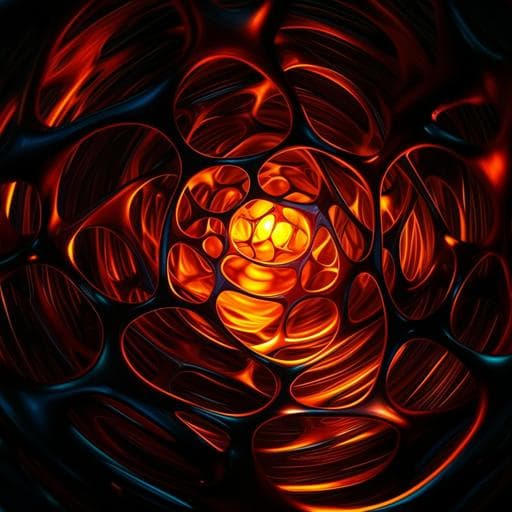
Engineering and Technology
High density mechanical energy storage with carbon nanothread bundle
H. Zhan, G. Zhang, et al.
This research unveils the remarkable potential of ultra-thin carbon nanothreads for high-density mechanical energy storage. Conducted by Haifei Zhan, Gang Zhang, John M. Bell, Vincent B. C. Tan, and Yuantong Gu, the study demonstrates that nano-bundle configurations can achieve a gravimetric energy density of 1.76 MJ kg⁻¹. Discover how these bundles outperform traditional carbon nanotubes with their unique energy storage mechanisms, pushing the boundaries of energy materials.
~3 min • Beginner • English
Introduction
Energy storage is a critical bottleneck for integrating intermittent renewable resources. Mechanical energy storage using high-strength carbon nanomaterials offers fast, efficient, stable, and reversible charging/discharging compared to electrochemical batteries. Carbon nanotube (CNT) fibers have been explored as mechanical energy storage media and harvesters, but their performance can be limited by structural complexity, processing variability, and deformation-induced flattening in large-diameter CNT bundles, which degrades mechanical response. Carbon nanothreads—ultra-thin, sp3-bonded, hydrogenated one-dimensional carbons—offer a potential alternative with high stiffness, tunable thermal properties, strong interlocking/functionalization potential, and consistent bundle fabrication. The research question is whether nanothread bundles can store high mechanical energy and how different deformation modes (torsion, tension, bending, radial compression) contribute to their gravimetric energy density compared to CNT bundles. The purpose is to quantify mechanical energy storage capacity of nanothread bundles via molecular dynamics (MD) and elasticity theory, identify dominant deformation modes, and propose pathways to maximize storage, including pure tension loading.
Literature Review
- CNT fibers: fabricated via spinning or twisting/rolling; structures include knitted, parallel, and twisted. Mechanical properties vary widely due to processing and post-treatments, with reported strengths 0.23–9.0 GPa and moduli 70–350 GPa; ultralong defect-free CNT bundles can reach >80 GPa tensile strength. However, common CNTs like (10,10) and (18,0) exhibit deformation-induced flattening that limits performance in bundles.
- Carbon nanothreads: predicted families include fully and partially saturated structures; sp3-bonded, ultra-thin with hydrogenated surfaces enabling inter-thread covalent bonding and strong interlocking. They show high stiffness (~850 GPa), bending rigidity (~5.35 × 10−28 N·m2), structure-dependent ductility, and tunable thermal conductivity. Single-crystalline packings have been synthesized, enabling exfoliation of bundles. Functionalization (e.g., –NH2) is feasible while retaining mechanical properties. Prior modeling frameworks for CNT bundles (Hooke’s law-based) inform analysis of bundle deformation energies.
- Gaps: Mechanical energy storage capacity of nanothread bundles and mode-by-mode contributions had not been systematically quantified, particularly relative to CNT bundles and under various bundle sizes.
Methodology
Study design: Combine large-scale molecular dynamics (MD) simulations with a continuum elasticity (Hooke’s law) framework to quantify strain energy density contributions from torsion, tension, bending, and radial compression for individual filaments and bundles, and to model twisted bundles of varying filament numbers.
Samples:
- Two representative carbon nanothreads: achiral polymer I (135462, nanothread-A) and chiral 134562 (nanothread-C), capturing linear and helical morphologies. Results are illustrative, not universally generalizable across all nanothread structures.
- CNT benchmark: (10,10) armchair single-walled CNT.
Interatomic potential and MD settings:
- AIREBO potential for C–C and C–H interactions, including short-range, Lennard-Jones (vdW), and dihedral terms.
- Cutoff adjusted to 2.0 Å to mitigate nonphysical tensile stresses from switching function.
- Temperature: 1 K to minimize thermal fluctuations.
- Time step: 0.5 fs.
- MD engine: LAMMPS.
- Stress calculation: virial stress; Von Mises stress used for local stress state visualization. Volume approximated assuming solid cylindrical beams; cross-sectional area via linear atom density times diamond reference atomic volume (5.536 Å3/atom).
Bundle construction:
- Close-packed triangular lattice arrangements with inter-thread separation determined via NPT relaxations: ~6.25 Å (nanothread-A), ~7.25 Å (nanothread-C), ~16.91 Å (CNT(10,10)). Bundles with filament counts n = 2–19 (bundle-n) were built to reflect close packing without excessive computational cost.
Deformation protocols:
- Torsion: Samples minimized, equilibrated (periodic along length), then twisted by applying constant opposite angular velocities at ends (2π/12,000 rad/ps; period 6000 ps). Non-periodic during loading; one end fixed, other free axially. Deformable length ~15 nm.
- Tension: Minimized, equilibrated (periodic along length), then non-periodic; one end fixed, the other pulled at 0.005 Å/ps, yielding a strain rate ~3 × 10−7 s−1; deformable length ~15 nm.
- Bending: Introduce initial curvature. For nanothreads (low bending stiffness), curvature maintained by adhesion to an idealized wall (LJ 9/3 potential, ε=0.65 eV, σ=2 Å). Curvatures 0.006–0.14 Å−1; sample length ~4 nm. For CNT(10,10), both ends fixed; sample length 8 nm; curvature 0.027–0.136 Å−1. Bending energy obtained by comparison to unbent references.
- Radial compression: Infinite triangular lattices with sixfold symmetry subjected to lateral NPT pressure cycling: relax at 0 GPa, compress to P, relax at P, release to 0, relax at 0; each stage 250 ps; multiple P values (38 tests for A, 23 for C, 34 for CNT). Periodic in all directions, T=1 K.
Theory and fitting:
- Linear elastic regime described by Hooke’s law: strain energy density ΔE_x/m = k_x ε_x^2 for modes x ∈ {torsion, tension, bending, compression}. Elastic constants k_x obtained via quadratic fits to MD energy–strain curves for each mode and material.
- Bundle model: Total energy density ΔE/M expressed as sum of mode contributions with torsional, tensile, bending, and compressive strains linked to bundle geometry (coil radius, inter-filament separation) and filament number n. For small n (≤7), closed-form relationships used to relate ε_t, ε_b, ε_c; energy minimization ∂E_tot/∂ε_c = 0 used to determine ε_c at given ε_t. Predictions compared to MD for validation, especially at low strains (<10%).
Key Findings
- Individual filament mechanics (from MD and fits):
• Torsion: Nanothread-A k_t ≈ 1.78 MJ kg−1, elastic limit ε_max ≈ 0.71, energy density ≈ 884 kJ kg−1. Nanothread-C k_t ≈ 2.70 MJ kg−1, ε_max ≈ 0.51, energy ≈ 737 kJ kg−1. CNT(10,10) shows early flattening at ε ≈ 0.06 with energy ≈ 65 kJ kg−1; three stages with k_t ≈ 19.76, 4.74, 2.78 MJ kg−1; fracture near ε ≈ 0.92 with energy ≈ 2720 kJ kg−1.
• Tension: Nanothread-A k ≈ 77.60 MJ kg−1, ε_max ≈ 0.18, energy ≈ 2051 kJ kg−1. Nanothread-C k ≈ 34.81 MJ kg−1, ε_max ≈ 0.15, energy ≈ 906 kJ kg−1. CNT(10,10) k ≈ 183.51 MJ kg−1; experimental elastic limit ~0.12 (energy ≈ 2374 kJ kg−1); MD maximum pre-fracture energy ≈ 6810 kJ kg−1 at ε ≈ 0.22.
• Bending: Nanothread-A k ≈ 5.12 MJ kg−1, ε_max ≈ 0.34, energy ≈ 468 kJ kg−1. Nanothread-C k ≈ 6.04 MJ kg−1, ε_max ≈ 0.28, energy ≈ 288 kJ kg−1. CNT(10,10) k ≈ 24.11 MJ kg−1; buckling at ε ≈ 0.05 with energy ≈ 49.3 kJ kg−1; maximum before bond breaking energy ≈ 618.6 kJ kg−1 at curvature ≈ 0.23.
• Radial compression: Nanothread-A k ≈ 43.74 MJ kg−1, ε_max ≈ 0.19, energy ≈ 6051 kJ kg−1. Nanothread-C k ≈ 31.80 MJ kg−1, ε_max ≈ 0.18, energy ≈ 3063 kJ kg−1. CNT(10,10) k ≈ 48.72 MJ kg−1; structural change (flattening) at ~1.4 GPa with ε ≈ 0.017 and energy ≈ 14.1 kJ kg−1; fully flattened lattice fractures near ε ≈ 0.33 with energy ≈ 4053 kJ kg−1.
- Bundles under torsion:
• Gravimetric energy density decreases with filament number n; torsion and tension dominate energy storage, compression negligible, bending minor.
• Nanothread-A bundle-3: ε_t limit ≈ 0.47 with ≈ 991 kJ kg−1; bundle-19: ε_t limit ≈ 0.14 with ≈ 370 kJ kg−1. Nanothread-C shows similar trend (bundle-3 ε_t ≈ 0.43; bundle-19 ≈ 0.14).
• CNT(10,10) bundle-19: ε_t limit ≈ 0.13, energy ≈ 577 kJ kg−1; torsional angles at elastic limit are much smaller than nanothread bundles (e.g., ~1.47 rad vs ~4.7–4.9 rad for nanothread bundle-19).
• Theoretical model matches MD well at small strains (<10%) and reasonably near elastic limits for nanothreads; deviations for CNT due to nonlinear flattening effects.
- Failure modes and scaling:
• For small bundles (n < 7): nanothread-A failure limited by bending; nanothread-C by torsion. For larger bundles, tensile strain limits elastic regime for both A and C; CNT bundles resemble nanothread-A behavior.
- Pure tension of bundles:
• Nanothread-A bundle-19 under pure tension achieves ≈ 1.76 MJ kg−1; nanothread-C ≈ 0.81 MJ kg−1. Normalized energy densities under tension decline modestly with n (A: ~94% to ~86% of single-filament tension capacity), whereas under torsion they drop by ~40% with increasing n.
- Benchmarking:
• Nanothread bundles’ maximum tensile gravimetric energy density (~1.76 MJ kg−1) exceeds steel springs by 4–5 orders of magnitude (~0.14 kJ kg−1) and is up to ~3× greater than Li-ion batteries (~0.43–0.79 MJ kg−1).
Discussion
The study establishes that in twisted nanothread bundles, torsion and tension are the primary contributors to mechanical energy storage, with tension increasingly dominant as bundle size grows due to increased coil radius. However, coupled deformation limits prevent reaching the individual-mode elastic limits simultaneously; outer filaments accrue higher tensile and bending strains and fracture earlier, capping storage below theoretical maxima. Compared to CNT bundles, nanothread bundles avoid early structural instabilities (flattening) and can endure larger torsional angles, yielding comparable gravimetric energy densities under torsion despite lower individual filament moduli. Critically, nanothreads’ hydrogenated surfaces enable inter-thread bonding, allowing pure tensile loading of bundles to exploit the higher tensile energy capacity per filament; this mode attains gravimetric energy densities rivaling or surpassing advanced batteries. The Hooke’s-law-based continuum model, parameterized by MD, captures mode contributions and trends well at low strain, offering design insights (e.g., mode dominance, failure-limiting strains) for optimizing bundle architectures. Functionalization or partial saturation to raise elastic limits, hierarchical structures, or pre-strain in outer filaments may further enhance torsional storage. Overall, nanothread bundles present a viable mechanical energy storage medium with practical advantages over CNTs and significant application potential in devices requiring rapid, reversible energy exchange.
Conclusion
This work quantifies the mechanical energy storage capacity of carbon nanothread bundles using MD-informed elasticity theory. Key contributions include: (1) identification of torsion and tension as dominant storage modes in twisted bundles, with gravimetric energy density decreasing as filament count increases; (2) demonstration that nanothread bundles avoid CNT-like flattening and achieve comparable torsional storage; (3) establishment that pure tensile loading of nanothread bundles can realize high gravimetric energy density up to ~1.76 MJ kg−1, surpassing Li-ion batteries and far exceeding steel springs. The findings highlight nanothreads’ unique structural advantages (hydrogenated, sp3-bonded surfaces permitting inter-thread bonding) to activate optimal storage modes. Future directions include experimental validation at finite temperatures and realistic strain rates, exploring partially saturated or functionalized nanothreads, hierarchical bundle designs, coarse-grained modeling of large bundles and inter-filament slippage, and extending to nanothread derivatives (e.g., carbon nitride) and mixed-chirality bundles.
Limitations
- Simulations performed at very low temperature (1 K); elastic limits and energy densities are likely overestimates relative to room temperature behavior.
- Applied strain rates, though quasi-static per MD step, are higher than experimental rates; lower rates may reduce elastic limits slightly.
- Empirical AIREBO potential introduces model dependence (e.g., cutoff choice at 2.0 Å); absolute property values may deviate from reality.
- Volume and cross-sectional area approximations affect stress magnitudes but not qualitative trends.
- Bundle models assume perfect, equal-length filaments without defects or slippage; real fibers may exhibit inter-filament sliding and defects. Large-scale slippage requires mesoscale/coarse-grained modeling beyond current MD resources.
- The linear elasticity model is most accurate at small strains; deviations occur near limits, especially for CNT due to flattening-induced nonlinearities.
- Results are illustrated for two nanothread structures (A and C) and may not generalize across all nanothread chemistries and topologies.
Related Publications
Explore these studies to deepen your understanding of the subject.







